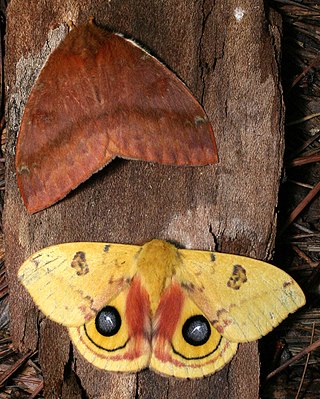
Automeris io, the Io moth or peacock moth, is a colorful North American moth in the family Saturniidae. The Io moth is also a member of the subfamily Hemileucinae. The name Io comes from Greek mythology in which Io was a mortal lover of Zeus. The Io moth ranges from the southeast corner of Manitoba and in the southern extremes of Ontario, Quebec, New Brunswick and Nova Scotia in Canada, and in the US it is found from Montana, North Dakota, South Dakota, Nebraska, Colorado, New Mexico, Texas, Utah, east of those states and down to the southern end of Florida. The species was first described by Johan Christian Fabricius in 1775.
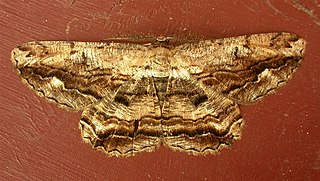
Scioglyptis lyciaria, the white-patch bark moth, is a moth of the family Geometridae that occurs in Australia. The species was first described by Achille Guenée in 1857.

Euchromius ocellea, the necklace veneer or belted grass-veneer, is a cosmopolitan migratory species of moth of the family Crambidae, first described by Adrian Hardy Haworth in 1811. It has Hodges number 5454.

Hypena baltimoralis, the Baltimore bomolocha or Baltimore hypena, is a moth of the family Erebidae. The species was first described by Achille Guenée in 1854. The moth flies from April to October depending on the location. There are at least two generations in New England and additional generations southward.

Eumacaria is a monotypic moth genus in the family Geometridae described by Packard in 1873. Its only species, Eumacaria madopata, the brown-bordered geometer moth, was first described by Achille Guenée in 1857. It is found in North America, where it has been recorded from British Columbia, northern Washington, southern Saskatchewan, from Maine to Florida, South Dakota, North Dakota, Nebraska, Wyoming, Idaho, Colorado and New Mexico. The habitat consists of orchards and shrublands. The species is listed as threatened in Connecticut.
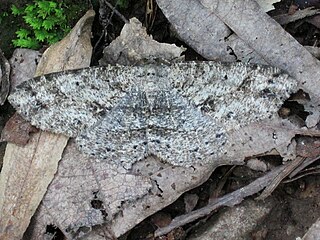
Melanolophia is a genus of moths in the family Geometridae described by George Duryea Hulst in 1896.

Protoboarmia porcelaria, the porcelain gray or dash-lined looper, is a Geometrid species of moth found throughout North America, except in the far north. The species was first described by Achille Guenée in 1857.

Idia americalis, the American idia or American snout, is a litter moth of the family Erebidae. The species was first described by Achille Guenée in 1854. It is commonly found in moist forests in North America, ranging from southern Canada to Florida and Texas. It is nocturnal and can be lured by sugar baits and light traps.

Lascoria ambigualis, the ambiguous moth, is a litter moth of the family Erebidae. The species was first described by Francis Walker in 1866. Adults are on wing from April to September. There are two generations in Connecticut and multiple broods in Missouri.
Notioplusia illustrata, the notioplusia moth, is a moth of the family Noctuidae first described by Achille Guenée in 1852. It is native to Saint Kitts, the Greater Antilles, Florida, Mexico, Panama and South America. It was introduced to Australia and South Africa.

Anticlea vasiliata, the variable carpet moth or early carpet, is a moth of the family Geometridae. The species was first described by Achille Guenée in 1857. It is known from the northern part of the United States and southern Canada, from Newfoundland and Labrador to Maryland, west to California, north to British Columbia.

Anavitrinella pampinaria, the common gray, is a moth of the family Geometridae. The species was first described by Achille Guenée in 1857. It is found in most of North America except the Arctic regions, south to Mexico.

Pleuroprucha insulsaria, the common tan wave moth, is a moth of the family Geometridae. The species was first described by Achille Guenée in 1857. It is found in eastern North America, from Nova Scotia to Florida, west to Texas and Colorado and north to Ontario. It ranges south through Mexico and Central America into South America and has been recorded as far south as the Galápagos Islands. It has also been recorded from the West Indies, including Jamaica.
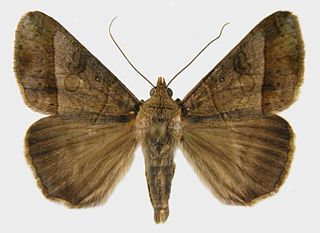
Mocis latipes, the small mocis moth or striped grass looper, is a species of moth of the family Erebidae. It is found from North America (from southern Ontario and Quebec to Florida, west to Arizona, north to Minnesota and south through Central to South America.
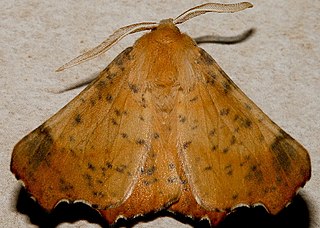
Ennomos magnaria, the maple spanworm moth, notched wing moth, notched-wing geometer or notch-wing moth, is a moth of the family Geometridae. The species was first described by Achille Guenée in 1858. It is found from coast to coast in southern Canada and the northern United States, south in the east to Florida and Louisiana and in the west to California.

Doryodes spadaria, the dull doryodes moth, is a moth of the family Erebidae. The species was first described by Achille Guenée in 1857. It is found in North America, where it has been recorded from coastal Florida, Georgia, North Carolina, South Carolina and Texas. The habitat consists of salt marshes.
Caberini is a tribe of geometrid moths in the family Geometridae. There are at least 50 described species in Caberini.

Tornos is a genus of geometrid moths in the family Geometridae erected by Morrison in 1875. There are about 17 described species in Tornos.
Melanolophia imperfectaria is a species of geometrid moth in the family Geometridae. It is found in North America.

Tornos scolopacinaria, the dimorphic gray, is a species of geometrid moth in the family Geometridae. It is found in North America.
















